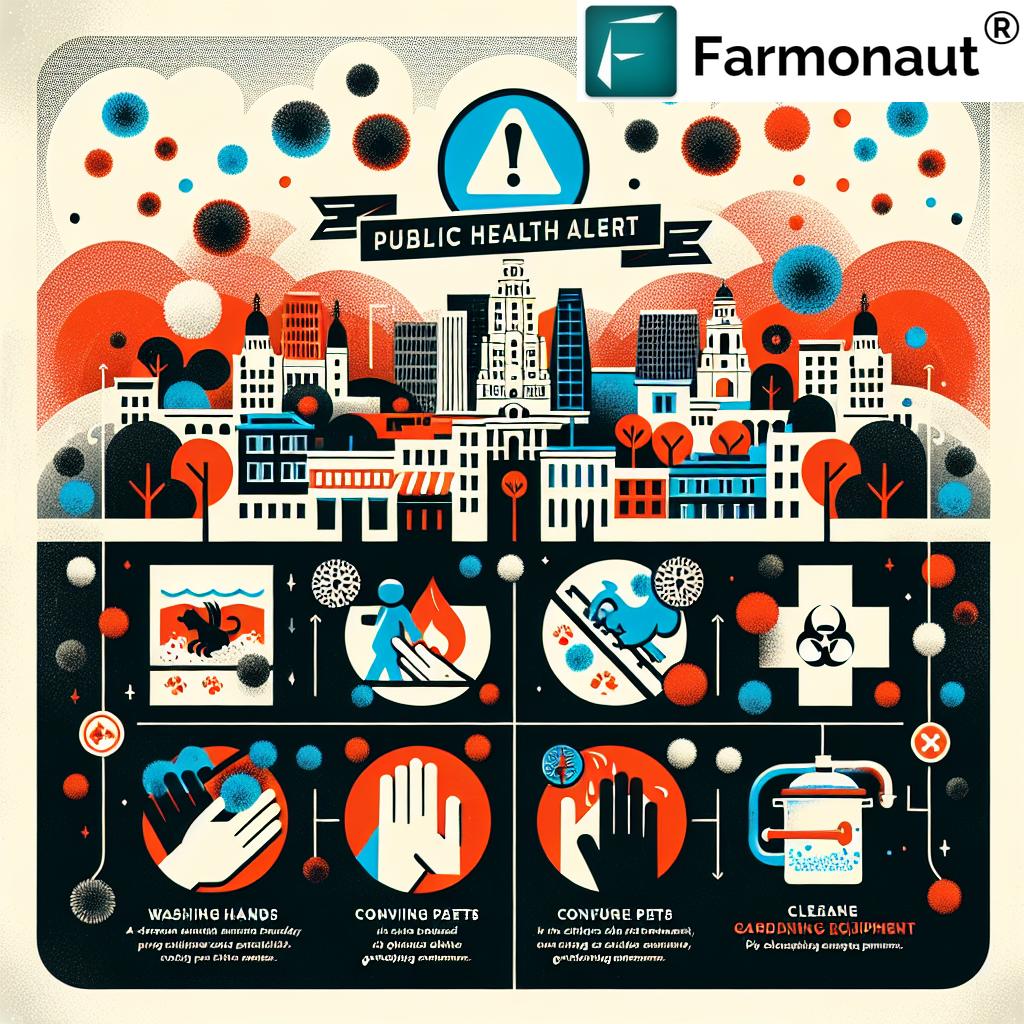Urgent: Pasadena Soil Safety Alert – High Lead Levels Detected After Eaton Fire, Crucial Precautions for Residents
“Recent soil testing revealed elevated lead levels in over 50% of samples from areas downwind of the Eaton Fire in Pasadena.”
In the wake of the devastating Eaton Fire that swept through Altadena and parts of Pasadena, California, we find ourselves facing a new and urgent challenge. The flames may have been extinguished, but the aftermath has left behind a concerning legacy in the form of lead contamination in soil. This blog post delves into the critical issue of post-wildfire soil safety, exploring the health risks associated with fire debris and outlining essential safeguards for affected communities to mitigate potential lead exposure.
As representatives of Farmonaut, a leading agricultural technology company, we understand the importance of soil health and its impact on both agriculture and human well-being. While our focus is typically on precision farming and crop management, the situation in Pasadena highlights the broader implications of environmental contamination on our communities.
The Eaton Fire: A Brief Overview
On January 7th, the Eaton Fire tore through the Altadena area, fueled by powerful winds that not only spread the flames but also dispersed ash and debris from hundreds of older homes. These structures, many containing lead-based paint and pipes, became an unexpected source of contamination as they burned and their remnants were carried southward by the wind.

Now, three months after the fire, public health officials have raised alarms about high lead levels in Pasadena and surrounding areas, extending well beyond the immediate burn zone. This discovery has prompted a series of investigations and calls for urgent action to protect residents’ health.
Soil Testing Results: A Cause for Concern
The Los Angeles County Department of Public Health conducted extensive soil testing at 780 different locations in and around the Eaton and Palisades fire areas. The results of this soil testing after wildfire have revealed a troubling pattern:
- Areas downwind of the Eaton Fire showed a higher percentage of soil samples with lead levels above health-based screening levels.
- The contamination extends beyond the burn zone, affecting areas previously thought to be safe.
- While the Palisades area showed localized contamination, including elevated levels of arsenic in some spots, no widespread fire-related chemical issues were found there.
These findings have significant implications for residents, particularly those living in areas that were not directly affected by the fire but are now dealing with the consequences of wind-borne contamination.
Understanding the Health Risks of Lead Contamination
Lead contamination poses serious health risks, especially to children and pregnant women. Exposure to lead can result in a range of health issues, including:
- Developmental delays in children
- Cognitive impairment
- Behavioral problems
- Anemia
- Kidney damage
- Hypertension in adults
The fire debris health risks extend beyond lead contamination. Ash and debris from burned structures can contain a cocktail of toxic substances, including heavy metals, asbestos, and various chemicals used in construction and household products.
At Farmonaut, we typically focus on soil health for agricultural purposes. However, our carbon footprinting technology can be adapted to help monitor and assess environmental impacts in urban areas affected by disasters like the Eaton Fire. This technology could potentially assist in mapping contamination spread and guiding remediation efforts.
Precautions for Residents: Protecting Your Health
In light of these findings, county officials are urging residents in the lead-affected areas to take immediate precautions. Here are some essential steps to minimize exposure:
- Frequent cleaning: Regularly clean your home, focusing on areas where dust accumulates.
- Keep pets safe: Prevent pets from playing in potentially contaminated soil to avoid tracking lead into your home.
- Practice proper hygiene: Wash hands thoroughly after outdoor activities, especially gardening.
- Clean children’s toys: Regularly wash toys that may come into contact with contaminated soil or dust.
- Consider raised garden beds: If you garden, consider using raised beds with clean soil to avoid contact with contaminated ground.
“Lead contamination from the Eaton Fire extended up to 5 miles beyond the immediate burn zone, affecting multiple neighborhoods.”
These precautions are crucial for lead exposure prevention and protecting the health of you and your family. It’s important to note that these measures should be taken even if you live outside the immediate burn area, as wind-borne contamination has extended the affected region significantly.
Government Response and Further Action
The discovery of widespread lead contamination has prompted a robust response from local and county authorities. Here are some of the actions being taken:
- County officials are requesting assistance from state and federal partners to conduct further environmental impact assessments.
- Options for more targeted lead soil testing are being explored to better understand the extent of contamination.
- Public health departments are conducting outreach to inform residents about the risks and necessary precautions.
- Considerations for soil remediation in the most affected areas are underway.
While these efforts are crucial, they also highlight the need for comprehensive environmental monitoring systems. At Farmonaut, we believe that technologies like our traceability solutions could be adapted to help track the spread of contaminants in situations like this, providing valuable data for public health officials and residents alike.

Long-term Implications for Agriculture and Gardening
The Altadena fire environmental impact extends beyond immediate health concerns. For those engaged in urban agriculture or maintaining home gardens, the presence of lead in soil poses significant challenges. Here are some considerations:
- Soil remediation: In heavily contaminated areas, soil may need to be removed and replaced or treated to reduce lead levels.
- Crop selection: Some plants are known to absorb less lead than others. Choosing these plants can help minimize the transfer of lead from soil to edible portions.
- Soil amendments: Adding organic matter and adjusting soil pH can help reduce the bioavailability of lead in soil.
- Regular testing: Ongoing soil testing will be crucial to monitor lead levels and ensure the safety of homegrown produce.
For larger-scale agricultural operations in the region, the situation underscores the importance of comprehensive soil monitoring and management practices. Farmonaut’s large-scale farm management solutions can play a crucial role in helping farmers monitor soil health and adapt their practices in response to environmental challenges like this.
Community Response and Support
In times of crisis, community solidarity is crucial. We’ve seen Pasadena and Altadena residents coming together to support one another and share information. Here are some ways the community is responding:
- Information sharing: Local community groups are organizing meetings and online forums to disseminate information about soil safety and precautions.
- Volunteer cleanup efforts: Some residents are organizing volunteer groups to help with cleanup in public areas, though it’s crucial that these efforts are coordinated with health officials to ensure safety.
- Support for vulnerable populations: Community organizations are reaching out to assist elderly residents and families with young children who may be at higher risk.
- Advocacy for comprehensive testing: Residents are calling for more extensive soil testing and transparent reporting of results.
This community response highlights the importance of accessible, accurate information in times of environmental crisis. While Farmonaut’s primary focus is on agricultural technology, our commitment to data-driven insights and environmental monitoring aligns with the needs of communities facing such challenges.
The Role of Technology in Environmental Monitoring
The Pasadena soil safety alert underscores the critical role that advanced technology can play in environmental monitoring and public health protection. While our focus at Farmonaut is primarily on agricultural applications, many of our technologies have broader potential uses:
- Satellite-based monitoring: Our satellite imagery analysis could be adapted to track the spread of contaminants over large areas, providing valuable data for public health officials.
- AI-driven analysis: Advanced artificial intelligence algorithms could help predict the movement of contaminants based on wind patterns and other environmental factors.
- Real-time data collection: Our systems for real-time crop health monitoring could be modified to provide ongoing environmental health data in affected areas.
These technologies, while not directly applicable in their current form, demonstrate the potential for innovative solutions in addressing environmental crises. As we continue to develop our agricultural technologies, we remain open to exploring how these tools might be adapted to serve broader community needs in situations like the one facing Pasadena and Altadena.
Looking Ahead: Lessons for Future Preparedness
The post-wildfire soil safety concerns in Pasadena and Altadena offer important lessons for communities everywhere. As climate change increases the frequency and intensity of wildfires, we must be prepared for the complex environmental challenges that follow. Here are some key takeaways:
- Comprehensive disaster response: Wildfire response must extend beyond immediate firefighting to include long-term environmental monitoring and remediation.
- Proactive soil testing: Regular soil testing in fire-prone areas can establish baselines and help quickly identify post-fire contamination.
- Public education: Communities need ongoing education about potential environmental hazards and precautionary measures.
- Technological integration: Leveraging advanced technologies for environmental monitoring can provide crucial data for decision-making and public safety.
At Farmonaut, we believe that the principles of precision agriculture and environmental monitoring that we apply in farming can be valuable in urban and suburban settings as well. Our crop plantation and forest advisory services, for instance, could potentially be adapted to help monitor and manage urban green spaces in fire-prone areas.
Lead Contamination Risk Levels and Precautions
| Risk Level | Estimated Lead Concentration (ppm) | Recommended Precautions |
|---|---|---|
| Low Risk | 0-100 |
|
| Moderate Risk | 100-400 |
|
| High Risk | 400+ |
|
Conclusion: A Call for Vigilance and Innovation
The discovery of high lead levels in Pasadena soil samples following the Eaton Fire serves as a stark reminder of the complex and often unseen consequences of natural disasters. As a community, we must remain vigilant, informed, and proactive in addressing these challenges.
While Farmonaut’s primary mission is to make precision agriculture accessible and affordable to farmers worldwide, the situation in Pasadena highlights the interconnectedness of environmental health, agriculture, and human well-being. The technologies and approaches we develop for agricultural sustainability have the potential to contribute to broader environmental monitoring and public health efforts.
As we move forward, it’s crucial that we continue to innovate, collaborate, and adapt our technologies to meet the evolving challenges posed by environmental disasters. By combining community action, governmental support, and technological innovation, we can work towards creating safer, more resilient communities for all.
FAQ Section
Q: How long will the lead contamination in Pasadena soil last?
A: The duration of lead contamination can vary depending on factors such as soil type, pH levels, and remediation efforts. Without intervention, lead can persist in soil for many years. Active remediation techniques can significantly reduce contamination levels more quickly.
Q: Are there any safe levels of lead in soil?
A: While there’s no “safe” level of lead exposure, the EPA has set a soil lead hazard standard of 400 parts per million (ppm) for bare soil in children’s play areas and 1,200 ppm for non-play areas. However, health effects can occur at lower levels, especially in children.
Q: How can I get my soil tested for lead?
A: Contact your local health department or environmental agency for guidance on soil testing. Many universities and private laboratories also offer soil testing services. Ensure the testing method is appropriate for detecting lead contamination.
Q: Can I still grow vegetables in my garden if the soil is contaminated?
A: If your soil is contaminated, it’s best to use raised beds with clean soil for growing vegetables. Alternatively, consider container gardening. Some plants absorb less lead than others, but it’s crucial to have your soil tested before growing edible plants.
Q: What should I do if I think I’ve been exposed to lead-contaminated soil?
A: If you’re concerned about lead exposure, consult your healthcare provider. They may recommend blood lead level testing, especially for children and pregnant women. Continue following the precautions outlined by health officials to minimize further exposure.
Additional Resources
For more information on soil health, environmental monitoring, and agricultural technology, explore these Farmonaut resources:
Download our mobile apps for on-the-go access to agricultural insights:
Earn With Farmonaut: Affiliate Program
Earn 20% recurring commission with Farmonaut’s affiliate program by sharing your promo code and helping farmers save 10%. Onboard 10 Elite farmers monthly to earn a minimum of $148,000 annually—start now and grow your income!
Farmonaut Subscriptions
By staying informed, taking necessary precautions, and leveraging innovative technologies, we can work together to address environmental challenges and create safer, more resilient communities.













